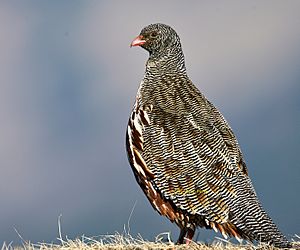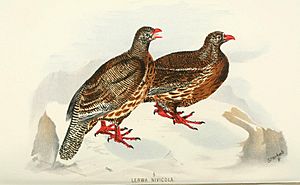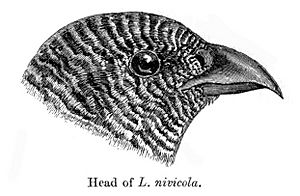Snow partridge facts for kids
Quick facts for kids Snow partridge |
|
|---|---|
 |
|
| Snow Partridge from Kedarnath Wildlife Sanctuary At Tungnath, Uttarakhand, India | |
| Conservation status | |
| Scientific classification | |
| Genus: |
Lerwa
|
| Species: |
lerwa
|
| Synonyms | |
|
Lerwa nivicola |
|
The snow partridge (Lerwa lerwa) is a type of bird that lives in high mountains. It belongs to the pheasant family. You can find these birds in the Himalayas across countries like India, Pakistan, Nepal, and China. It's the only species in its group, called Lerwa. Snow partridges live in grassy mountain areas above the tree line. They prefer places with some plants, not just bare rocks. Unlike some other mountain birds, they are not as shy. Male and female snow partridges look very much alike. However, males have a small spur, like a claw, on their leg.
Contents
What Does a Snow Partridge Look Like?
This partridge has grey feathers on its upper body and chestnut (reddish-brown) feathers underneath. Its beak and legs are bright red. Its upper feathers have fine black and white stripes. When it flies, its dark brown wing feathers with a thin white edge make it look a bit like the much larger Tibetan snowcock.
The tail has 14 feathers and is dark with white stripes. Some birds have a crown (top of the head) that is almost black. The chest is a deep chestnut color. The belly has more white, and the lower sides of its body have brown and white stripes.
Snow partridges are about 38–40 cm (15–16 inches) long. Females weigh between 450–580 grams (about 1 to 1.3 pounds). Males are a bit heavier, weighing 550–700 grams (about 1.2 to 1.5 pounds). Males have a blunt spur on their leg, and sometimes even a second small one. Females do not have these spurs. Young birds have less clear stripes and mottled lower parts. Baby chicks look similar to baby blood pheasants. Their legs are feathered, and their nostrils are covered by feathers.
Where Do Snow Partridges Live?
Snow partridges live in the Himalayas, from Pakistan all the way to Arunachal Pradesh in India. They usually live at very high altitudes, mainly between 3,000 to 5,000 meters (about 9,800 to 16,400 feet). They are rarely found below 2,000 meters (6,500 feet).
They live above the tree line, which is where trees stop growing due to the cold and high altitude. However, they do not live in areas that are completely bare and stony, unlike some other mountain birds. Even though they are found over a large area, they are not found everywhere. They prefer specific local spots.
Their favorite places are mountain pastures with grass, lichens, moss, ferns, and rhododendron plants. They can be found near small patches of snow. The good news is that there are many snow partridges, so they are not currently a big worry for conservation. However, people do hunt them because they are easier to approach than some other birds, which has caused their numbers to go down in some areas.
Snow Partridge Behavior and Life Cycle

Snow partridges usually live in small groups of about 6 to 8 birds. Outside of the breeding season, these groups can grow to up to 30 birds. When they are startled, they fly up quickly with noisy wing beats and scatter. Their flight is fast and powerful.
These birds like to sunbathe on rocks during the middle of the day. During the breeding season, the male's call sounds a bit like the grey francolin bird found in the plains. Snow partridges are similar in habits to ptarmigans, another type of mountain bird. They eat mosses, lichens, berries, and plant shoots. They also swallow small stones, called grit, to help them digest their food.
Reproduction and Nesting
The breeding season for snow partridges is from May to July. It is believed that male and female snow partridges stay together as a pair. The nest is a simple scrape on a hillside, often under a sheltering rock. They might dig the scrape themselves or use one that is already there. The nest is usually hidden by plants. Sometimes, they line the nest with moss.
A female snow partridge lays about 3 to 5 eggs. The eggs are pale yellow and slightly shiny, with reddish-brown marks on the rounded end. The female sits on the eggs to keep them warm, while the male stands guard nearby. If a predator comes close, the parent birds might pretend to be hurt to distract the predator away from the nest. They call to their young with a soft, low sound, and the chicks respond with chicken-like "cheep" calls.
See also
 In Spanish: Perdiz Lerwa para niños
In Spanish: Perdiz Lerwa para niños



